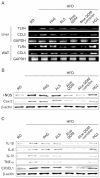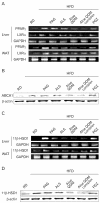Dietary Aloe Improves Insulin Sensitivity via the Suppression of Obesity-induced Inflammation in Obese Mice
- PMID: 21494375
- PMCID: PMC3072676
- DOI: 10.4110/in.2011.11.1.59
Dietary Aloe Improves Insulin Sensitivity via the Suppression of Obesity-induced Inflammation in Obese Mice
Abstract
Background: Insulin resistance is an integral feature of metabolic syndromes, including obesity, hyperglycemia, and hyperlipidemia. In this study, we evaluated whether the aloe component could reduce obesity-induced inflammation and the occurrence of metabolic disorders such as blood glucose and insulin resistance.
Methods: Male C57BL/6 obese mice fed a high-fat diet for 54 days received a supplement of aloe formula (PAG, ALS, Aloe QDM, and Aloe QDM complex) or pioglitazone (PGZ) and were compared with unsupplemented controls (high-fat diet; HFD) or mice fed a regular diet (RD). RT-PCR and western blot analysis were used to quantify the expression of obesity-induced inflammation.
Results: Aloe QDM lowered fasting blood glucose and plasma insulin compared with HFD. Obesity-induced inflammatory cytokine (IL-1β, -6, -12, TNF-α) and chemokine (CX3CL1, CCL5) mRNA and protein were decreased markedly, as was macrophage infiltration and hepatic triglycerides by Aloe QDM. At the same time, Aloe QDM decreased the mRNA and protein of PPARγ/LXRα and 11β-HSD1 both in the liver and WAT.
Conclusion: Dietary aloe formula reduces obesity-induced glucose tolerance not only by suppressing inflammatory responses but also by inducing anti-inflammatory cytokines in the WAT and liver, both of which are important peripheral tissues affecting insulin resistance. The effect of Aloe QDM complex in the WAT and liver are related to its dual action on PPARγ and 11β-HSD1 expression and its use as a nutritional intervention against T2D and obesity-related inflammation is suggested.
Keywords: Aloe QDM complex; Insulin sensitivity; Obesity-induced inflammation; Type 2 diabetes mellitus.
Conflict of interest statement
The author have no financial conflict of interest.
Figures





Similar articles
-
Dietary Aloe Reduces Adipogenesis via the Activation of AMPK and Suppresses Obesity-related Inflammation in Obese Mice.Immune Netw. 2011 Apr;11(2):107-13. doi: 10.4110/in.2011.11.2.107. Epub 2011 Apr 30. Immune Netw. 2011. PMID: 21637388 Free PMC article.
-
Dietary Aloe QDM Complex Reduces Obesity-Induced Insulin Resistance and Adipogenesis in Obese Mice Fed a High-Fat Diet.Immune Netw. 2012 Jun;12(3):96-103. doi: 10.4110/in.2012.12.3.96. Epub 2012 Jun 30. Immune Netw. 2012. PMID: 22916045 Free PMC article.
-
Dietary capsaicin reduces obesity-induced insulin resistance and hepatic steatosis in obese mice fed a high-fat diet.Obesity (Silver Spring). 2010 Apr;18(4):780-7. doi: 10.1038/oby.2009.301. Epub 2009 Oct 1. Obesity (Silver Spring). 2010. PMID: 19798065
-
Resveratrol reduces the inflammatory response in adipose tissue and improves adipose insulin signaling in high-fat diet-fed mice.PeerJ. 2018 Jun 29;6:e5173. doi: 10.7717/peerj.5173. eCollection 2018. PeerJ. 2018. PMID: 29967759 Free PMC article.
-
Recent advances in the relationship between obesity, inflammation, and insulin resistance.Eur Cytokine Netw. 2006 Mar;17(1):4-12. Eur Cytokine Netw. 2006. PMID: 16613757 Review.
Cited by
-
Obesity Enhances Antioxidant Capacity and Reduces Cytokine Levels of the Spleen in Mice to Resist Splenic Injury Challenged by Escherichia coli.J Immunol Res. 2020 Feb 11;2020:5948256. doi: 10.1155/2020/5948256. eCollection 2020. J Immunol Res. 2020. PMID: 32104715 Free PMC article.
-
Comparative evaluation of anti-obesity effect of Aloe vera and Gymnema sylvestre supplementation in high-fat diet fed C57BL/6J mice.J Intercult Ethnopharmacol. 2016 Jun 25;5(4):403-407. doi: 10.5455/jice.20160623122710. eCollection 2016 Sep-Dec. J Intercult Ethnopharmacol. 2016. PMID: 27757271 Free PMC article.
-
Fish and the Thyroid: A Janus Bifrons Relationship Caused by Pollutants and the Omega-3 Polyunsaturated Fatty Acids.Front Endocrinol (Lausanne). 2022 May 27;13:891233. doi: 10.3389/fendo.2022.891233. eCollection 2022. Front Endocrinol (Lausanne). 2022. PMID: 35712237 Free PMC article. Review.
-
Dietary Aloe Reduces Adipogenesis via the Activation of AMPK and Suppresses Obesity-related Inflammation in Obese Mice.Immune Netw. 2011 Apr;11(2):107-13. doi: 10.4110/in.2011.11.2.107. Epub 2011 Apr 30. Immune Netw. 2011. PMID: 21637388 Free PMC article.
-
Obesity theranostics using nanoemulsions of probiotics and local herbs.Saudi J Biol Sci. 2023 Oct;30(10):103790. doi: 10.1016/j.sjbs.2023.103790. Epub 2023 Aug 23. Saudi J Biol Sci. 2023. PMID: 37680978 Free PMC article.
References
-
- Pickup JC, Crook MA. Is type II diabetes mellitus a disease of the innate immune system? Diabetologia. 1998;41:1241–1248. - PubMed
-
- Grimble RF. Inflammatory status and insulin resistance. Curr Opin Clin Nutr Metab Care. 2002;5:551–559. - PubMed
-
- Uysal KT, Wiesbrock SM, Marino MW, Hotamisligil GS. Protection from obesity-induced insulin resistance in mice lacking TNF-alpha function. Nature. 1997;389:610–614. - PubMed
LinkOut - more resources
Full Text Sources
Research Materials
Miscellaneous

